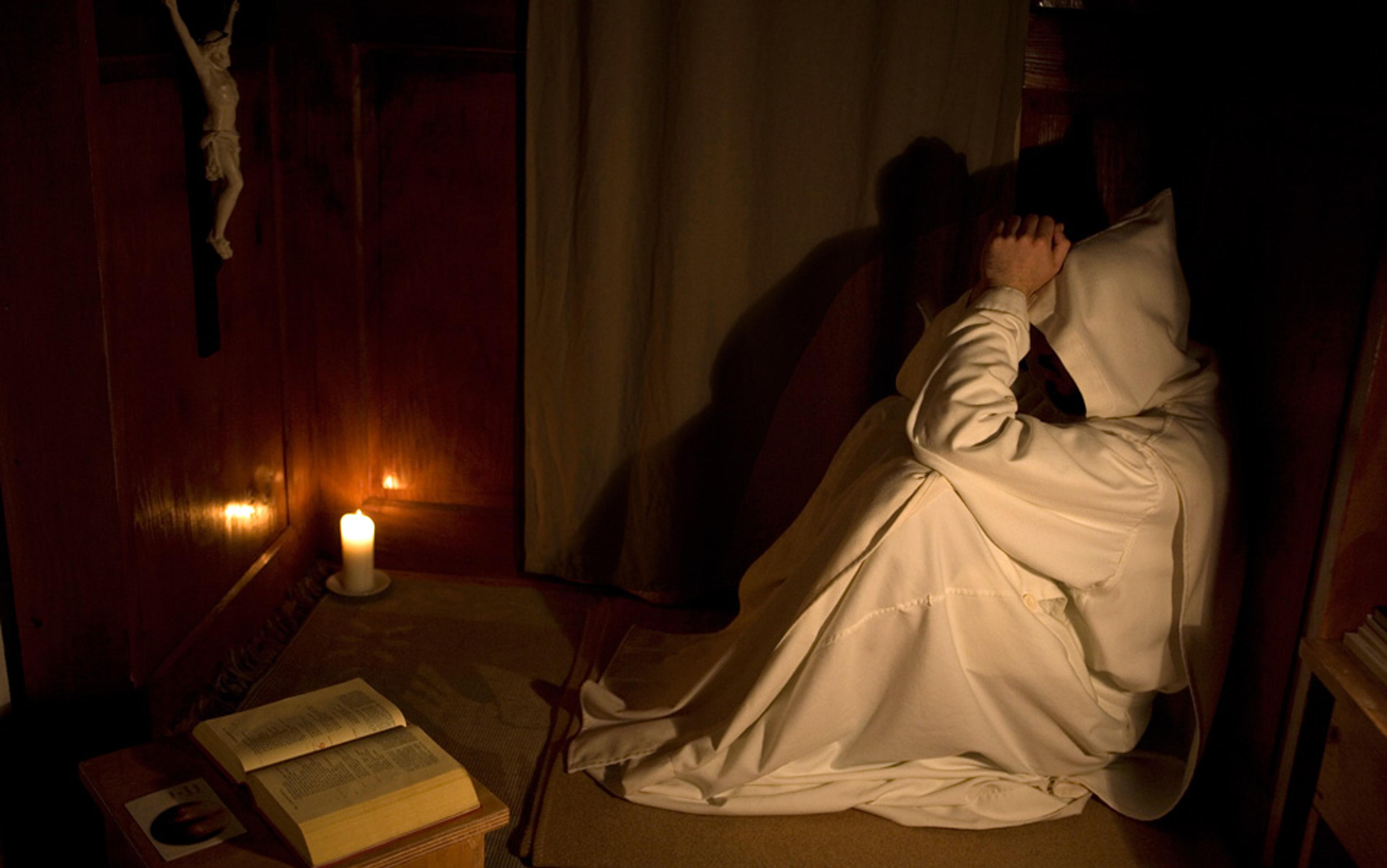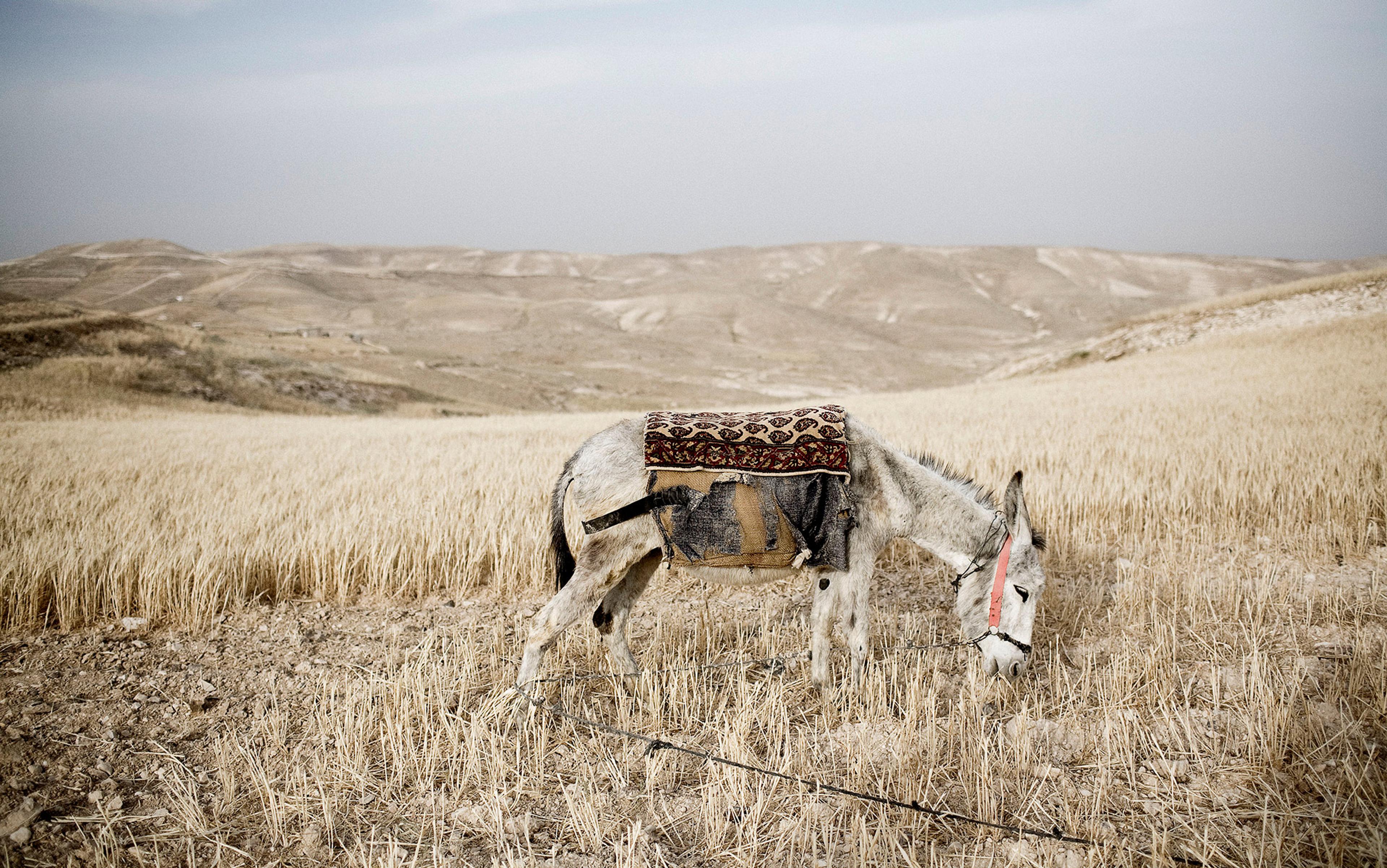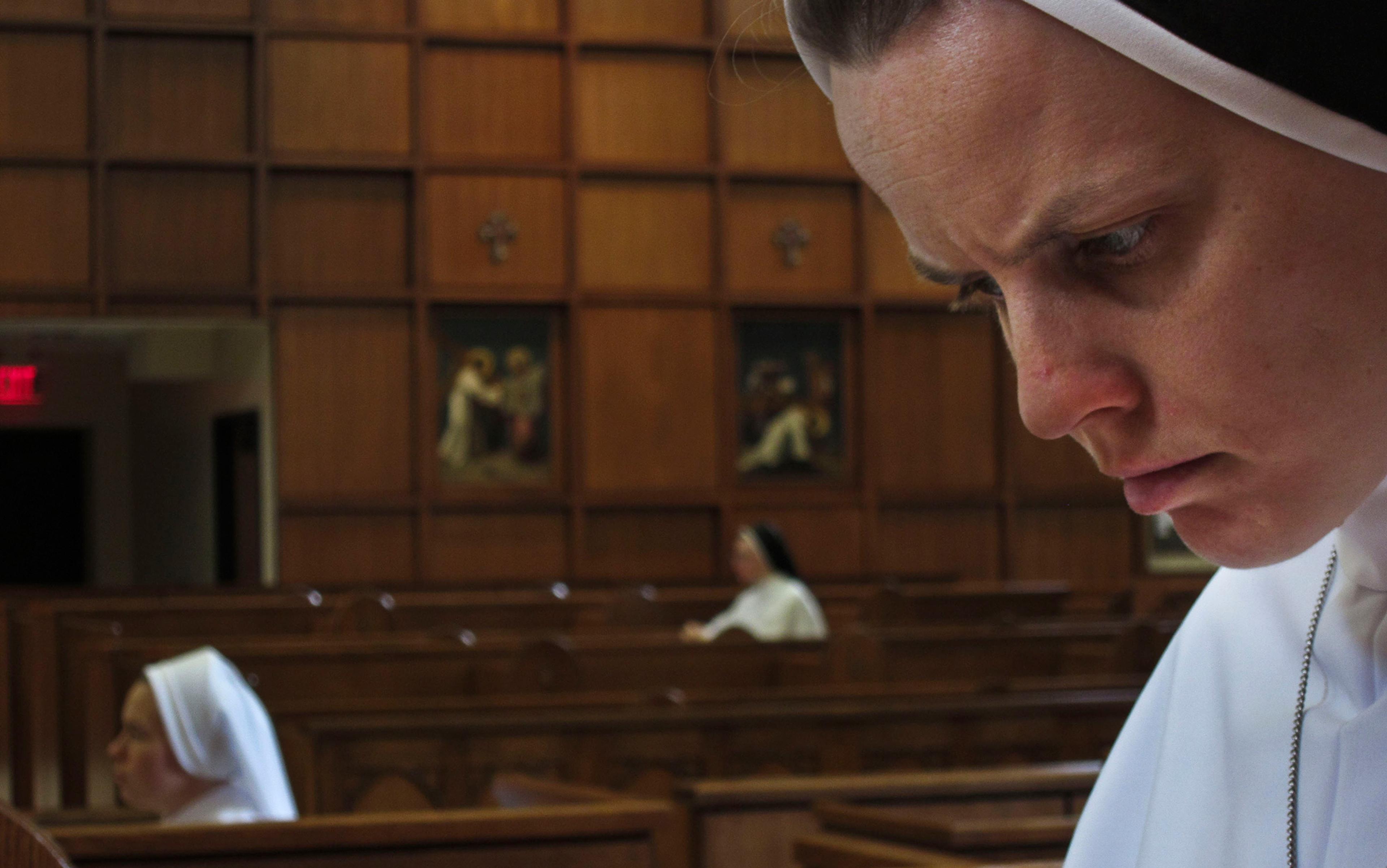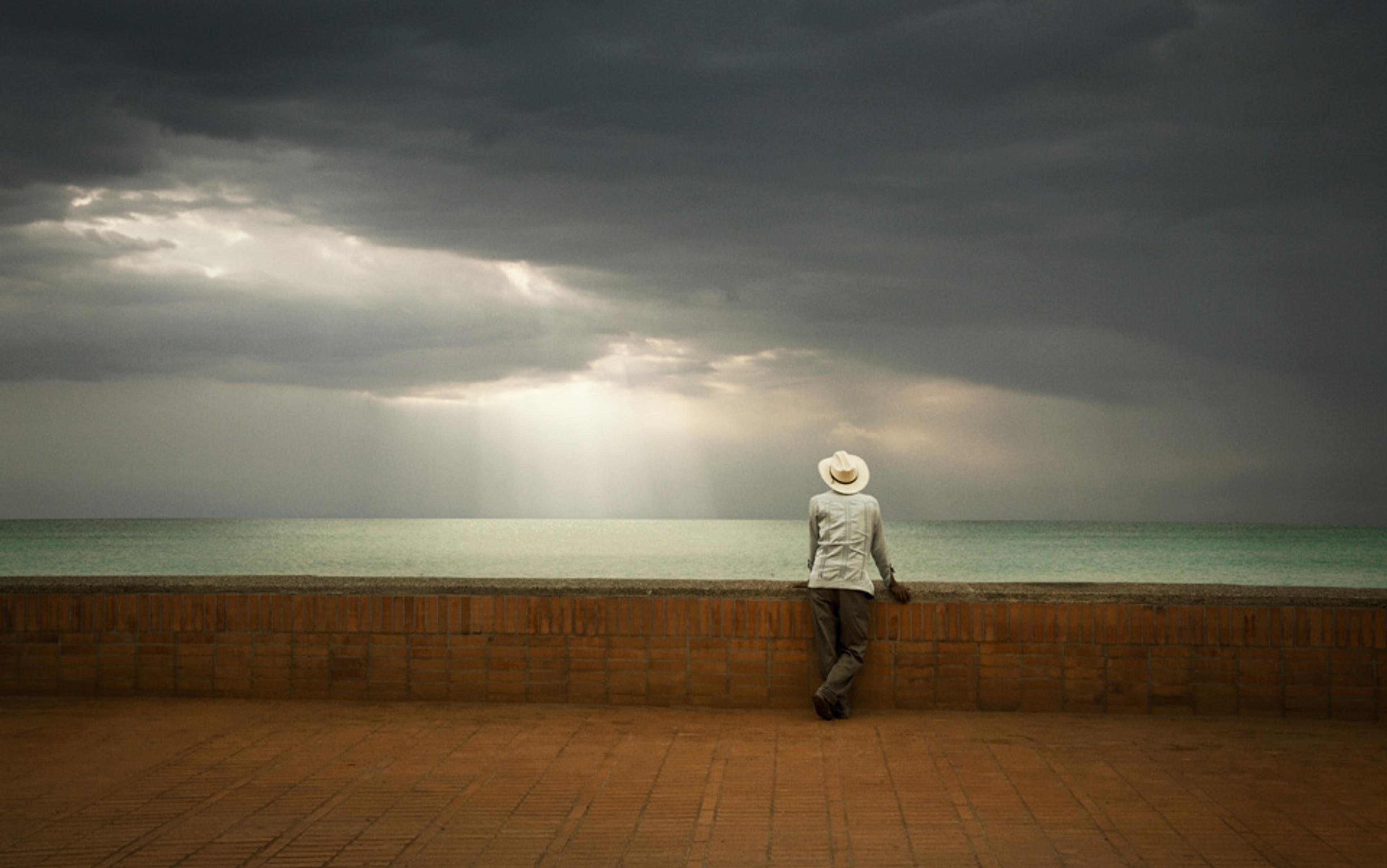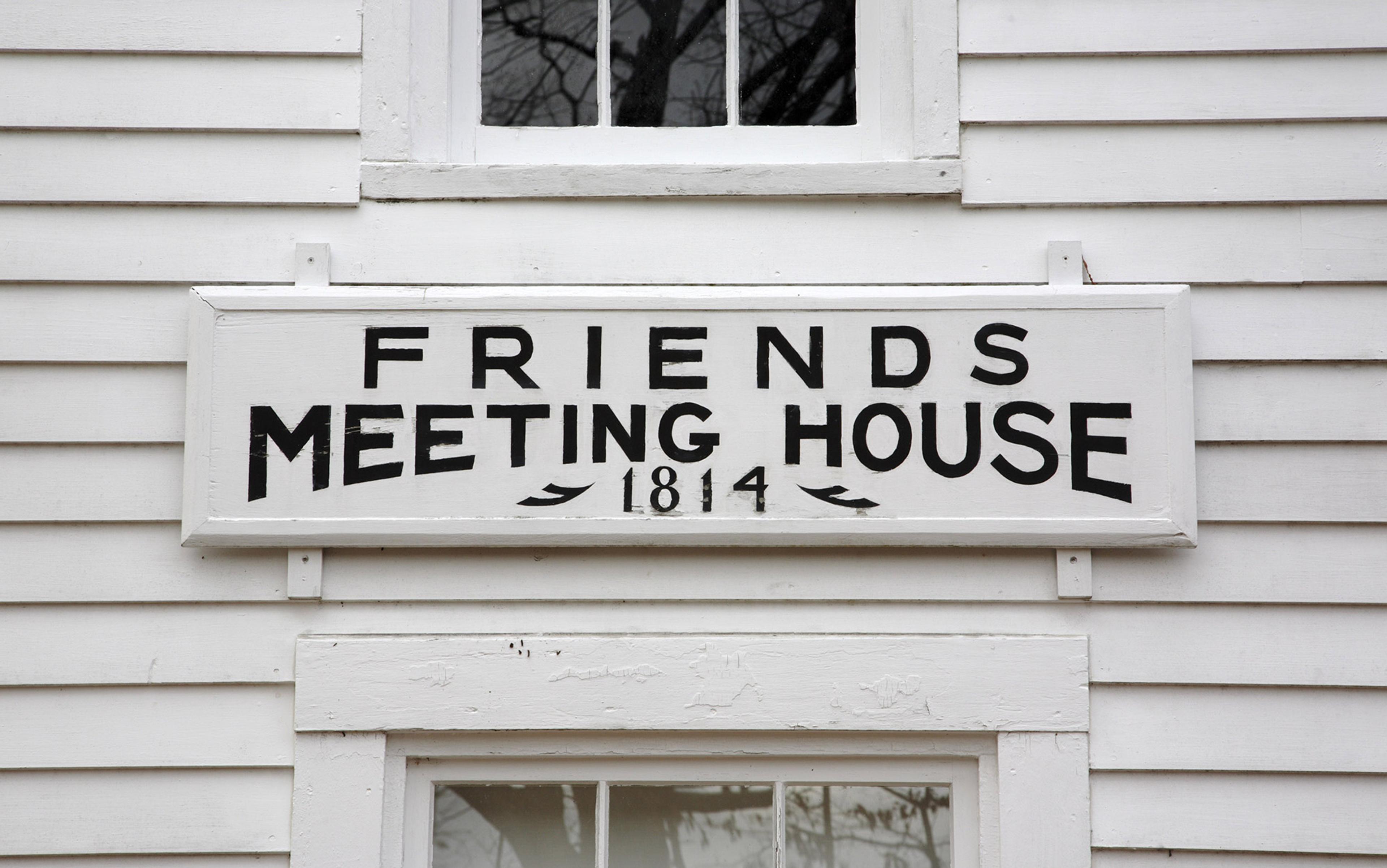How do you know when you really belong somewhere? When you’re truly welcome, beyond the politeness of good people?
The simple wooden cross a few feet away from me on the carpet is offset — aesthetically and theologically — by some ambiguously spiritual pieces of crumpled coloured linen that are strewn in front of it. The linen says: ‘Don’t worry about the cross so much.’ The cross says: ‘Take the linen seriously.’
We sit down on the floor. Others come to join us, choosing cushions, wooden chairs or little kneelers according to taste and physical condition. Eight of us in all, gradually forming a horseshoe around this enigmatic centrepiece, whose final touch is a Tibetan singing bowl. With the cross and the crumples, it makes up the Holy Trinity of contemporary Christian meditation.
Just how happily those two words sit together — ‘Christian’ and ‘meditation’ — is part of my difficulty here, as I get used to my surroundings in this Edinburgh prayer group. That same question has been a matter of some controversy ever since the movement to revive the contemplative dimension of Christianity got going in the 1970s. Talking about ‘revival’ gives away one’s sympathies, of course. It insists that this isn’t just Western Christianity’s rearguard action against its rivals in the New Age and Asian philosophy camps — that it represents an authentic strand of Christian tradition, albeit one long left for dead by our obsessively verbal modernity. The three founders of the modern movement certainly claim deep roots for it. All three were monks, and while most of Christendom dozed or counted the minutes in creaky church pews, they were practising the spirituality of the Desert Fathers, The Cloud of Unknowing and Teresa of Avila. They knew the Christian past, and were convinced they knew what its future must be.
One day Thomas Keating received a rare knock at his Trappist monastery door in New England. When he went to answer it, the youthful caller only wanted directions to a nearby Buddhist meditation retreat. ‘But we do that here!’ Keating thought to himself, as the boy wandered off down the road. Inspired by the encounter, he helped to create a new ‘Centering Prayer’ practice, blending Christian spirituality with the language of modern psychology.
Two English Benedictines travelled a similar path. Bede Griffiths was living in a Christian ashram — ‘Shantivanam’ — by the side of the Kaveri River in Tamil Nadu, garbed in the saffron robes of a holy man and learning everything he could from Indian spirituality, music, art, liturgy and prayer. Finding that his ashram was filling up with Western refugees from a frigid, fossilised Christianity, he wrote a series of influential books calling for renewal, in dialogue with India’s contemplative traditions. Meanwhile, John Main was taking the mantra-based meditation practice he’d learned from an Indian monk and setting up a meditation centre in London. He soon followed it with a priory in Montreal, and his successor, Laurence Freeman, later helped to create the World Community for Christian Meditation (WCCM).
Both the WCCM and Keating’s organisation, Contemplative Outreach, have since gone global, their leaders racking up the air miles in support of fledgling meditation groups and promotional work around the world. Keating ended up learning to meditate in airports. Freeman always seems to be just back from one country and packing his bags for another — from Brazil to Poland, Australia to Haiti. If Christian meditation retains the ‘peace and love’ spirit of the bell-bottomed generation who revived it, it does so in serious and pragmatic ways.
A deep, lingering note from the singing bowl signals the start of 20 minutes of silence. This is the heart of Christian meditation. In other Christian circles, prayerful consideration of a text, theme or question is also referred to as ‘meditation’, but the meaning of the word here is closer to the silent Asian traditions that helped touch off the new movement. Techniques vary: Centering Prayer uses a ‘sacred word’, gently repeated until it naturally drops out into silence. The WCCM continues with John Main’s practice of continuously repeating a mantra. Both call for two periods of prayer per day, of around 20 minutes.
I give up 10 minutes in, and start planning this essay. There’s some comfort in the thought that my mother-in-law spends Zen sessions at her local temple planning the week’s shopping. Eventually, the first murmurings of the ‘Our Father’ begin, people joining in as they emerge from silent prayer. And this is the point at which ‘Christian meditation’ gets tricky, for some of us, anyway.
I wait in trepidation for the sales pitch, for the moment the conversation corners me with specific, committed talk of God
If Christians have historically been suspicious about the ‘meditation’ bit — too Oriental, bound to give rise to confusion over Church authority or teachings — others, who otherwise like the sound of meditation, don’t quite know what to make of the ‘Christian’ part. The atmosphere is kind and tolerant, but as a guest I’m not sure what the common assumptions are here, what the shared territory of belief is, or even how much it matters. I wait in trepidation for the sales pitch, for the moment the conversation corners me with specific, committed talk of God.
Buddhist forms of meditation — at least in their Western incarnations — tend to start from the bare existential situation that we all share. How, in the Christian versions, does silence work alongside biblical revelation and interpretation and Church teachings? How much room is there for doubt over these things? It’s fashionable (and fair) to point out that Christianity is more than a series of propositions about how the world works. As someone who was brought up a Catholic, with our manifesto-like little red catechism, I still sometimes forget the breadth that ‘Christianity’ encompasses. Yet few forms of Christianity are altogether devoid of doctrine and, while conversation in Christian meditation groups such as this one ranges surprisingly free, the question remains: where is the bar being set for what it means to be a Christian?
For Laurence Freeman, briefly home at his Ealing base, this is a natural concern for anyone new to Christian meditation but it’s misleading as a starting point. People from all sorts of Churches — and none — come together to practise: meditation builds its own ‘community of faith’, Freeman says — faith, in this sense, being ‘our capacity for relationship, for enduring, transcending the instinct to run away and have an easier time somewhere else’.
This is ‘faith’, then, not as some watered-down alternative to propositional belief, but a commitment made and remade even while its object comes into view only gradually and uncertainly (‘through a glass, darkly’, as St Paul put it). It’s a commitment, too, to facing whatever silence throws at you. Boredom and busy schedules are familiar obstacles in any meditation practice, Christian or otherwise, but tougher still are those times when practitioners find themselves frightened or unwilling to follow where the silence seems to be leading them. Questions of theology and Church teaching will come up, of course, but Freeman insists that we must allow them to emerge in the midst of all the other doubts — about ourselves and the world — that arise as we practise. As he puts it, meditation ‘opens Pandora’s box… everything starts to look different’.
Committed Christians might be disturbed by a radical new light thrown upon Church structures and teachings. For those of us here out of curiosity, the nature of the disturbance might be that the lines between what is ‘religious’ and what is not begin to blur. Our tendency to compartmentalise life into religious and secular realms, or private and public ones, starts to feel less like a necessary guarantor of tolerance and more an evasion, even an act of violence against the real grain of life. Teaching meditation to business leaders in the US, Freeman finds that they often start out expressing avowedly secular goals, yet some go on to have an experience that leaves such concerns looking rather pale — they experience things that are ‘undeniable… that they don’t even want to deny’.
This gives Christian meditation the potential to function as rather more than a woolly indulgence. Offering techniques of meditation to people who lack money, power, control — Freeman recently worked with young people in Haiti, their economy and prospects in ruins — is a ‘political act’, in his words. When people are able to yield, even a little, to what they find in silence, Freeman says that tangible effects follow: they reject the idea that their status quo is somehow ‘fate’ and discover fresh moral resources to do something about their situation. And when similar shifts occur in those who do have power — those business leaders, say, or the members of Ireland’s Royal College of Physicians, for whom Freeman recently ran a retreat — the various parts of society can start moving towards one another on the basis of something greater than calculation or guilt.
Back in our little group, conversation is personal rather than political: good-natured but also careful and self-conscious. The participants are mostly middle-aged, and there’s a sense that the men — in a clear minority here — are happier exchanging facts and quotes about spirituality instead of the necessary intimacies. A certain dread of humiliation — one’s own or that of others — seems to be at work (and if I say that what we are attempting here is to ‘share’, and you wince at the word, you are probably familiar with the kind of dread I mean). Particularly hard to hear are the stories that people tell about themselves, about what brought them to meditation and what is changing as their practice progresses. Problems of belonging and belief in Christian meditation are bound up, it seems, with a third difficulty: the lure and perils of narrative.
The classic theme here is that of the prodigal child, one who wanders far and wide through all manner of dissatisfaction, self-deceit, and danger. At last she stumbles — or is drawn — homeward, where she has always been both loved and confidently expected.
Augustine’s Confessions (398) and Thomas Merton’s The Seven Storey Mountain (1948) follow this archetypal pattern, and the modern revival of Christian meditation was launched, in part at least, by a third work in a similar vein: Bede Griffiths’s spiritual autobiography, The Golden String (1954). Griffiths’s work stands out in one crucial regard. It shows how any narrative of spiritual or religious life up to the present point is always a combination of discovery and creation, and as such a potential source both of insight and confinement. Such narratives are to be worn lightly, understood as a ‘maybe’ and never as a last word.
In The Golden String, written some 20 years after he became a Benedictine, Griffiths recalled being drawn, as a young boy, to ever-longer country walks, and finding his experiences and feelings amid nature echoed in the poetry of Wordsworth and Coleridge, and in time he made links to Plato — discovering an intellectual expression of the good, the true, the beautiful. Romantic misgivings followed at university, about modernity and industrialisation: old pastoral rhythms of life drowned out by the tick-tock of factory clocks; new military technologies pounding and mincing young flesh in the Great War. T S Eliot’s Wasteland (1922) served to confirm everything that had gone before in Griffiths’s developing understanding of the world, and now he went as far as setting up a Cotswolds commune with like-minded friends, determined to slam a cottage door on as much of the modern world as they could.
Even the deflating experience of an actual church service can’t put Griffiths off. He prays out on the frozen clay, in the bracing country cold
Turning the pages of The Golden String today, it all starts to add up: one thing leading to another, everything clicking into place. In the pages of Augustine, Griffiths finds that the strange magic of his boyhood rural walks is not just echoed, as with Wordsworth, or schematised, as in Plato, but actually named — as the Christian God. He’s gripped by Mark’s gospel account of what Jesus said and did, and by Paul’s tirades against pagan culture and the thoughtless, loveless application of Mosaic Law — all of which read to him like the most effective possible assault on his own hidebound times. At last, he sees it: the Christian ideal of ‘Church’ is not the empty, justifiably fading social institution he’d thought, but an ongoing — albeit often tragically wayward — attempt to build a counter-cultural community. Even the deflating experience of an actual church service, poor cousin of the vivid worlds through which Aquinas and Dante have recently been escorting him, can’t put him off. He prays out on the frozen clay, in the bracing country cold. The priesthood beckons.
And then, at this crucial moment, it all comes tumbling down. Griffiths has been staying for a while in a little room at the top of a house in Bethnal Green in east London when he starts to hear voices. The first thing he hears is ‘repent’. But what is there to be sorry for? He can think of nothing. All the same, he is worried: hearing voices clearly isn’t good. Maybe his recent experiments with fasting are taking a toll, not to mention the lack of contact with others: another no-no for your mental health. Best to get up off the bedroom floor, rub the knees, go out for a bite to eat.
But something about where this voice was coming from makes him pause. It comes from somewhere beyond the bright, pleasing little constellation of Platonic ideals and poetic conjurings he’s been moving through of late; somewhere beyond those sweet Pauline turns of phrase, the awesome medieval aesthetics, his own orderly future plans. And this ‘somewhere’ starts exerting a disturbing sort of vacuum pull towards itself — towards, so it seems to Griffiths, nothing at all.
Thought can get no purchase on it. Surely this too is a reason to back away — to shake the whole thing off as some silly mood. But Griffiths’s whole critique of the world and his own spiritual trajectory suddenly feels unnervingly partial. Lovingly fashioned from the best that his culture could offer, its most significant element is now the space around and inside it: everything that it hasn’t addressed, or couldn’t. So he is forced to pay attention, rooted to the spot hour after hour. Strangely, what comes into question isn’t his faulty reasoning or the faultiness of reason in general, but his autonomy, his will — appearing now more like an obstacle than an asset. The mundane world is disgusting to him, he realises, largely because he is a person in whom disgust is strong; it is to be held at arm’s length because he is someone who needs to hold things at arm’s length; and it is pointlessly peripheral because Griffiths has been placing himself at the centre of everything.
What else is there? Letting go when there is no hint of what might be gained seems crazy. And yet his former life, which had so recently arrived at its great prodigal moment, suddenly has little to recommend it. Exhausted, the image comes to him of Jesus in the Garden of Gethsemane, facing death. All he can do, he decides, is place himself next to Christ in the garden and give up.
By the time morning rolls around, Griffiths is a different person. It isn’t that his earlier conversion was fake and this frightening overnight encounter is somehow the real thing. Rather, he has entered into a form of life in which both revelations will constantly play off against one another: the theorising and speculation that fuelled his first conversion against this new, vivid sense of how feeble words by themselves are, separated from the being of the person who thinks, speaks, and writes them — or the person who hears and reads. It is out of such a wealth of personal confusion that Griffiths comes to define faith as ‘utter receptivity’.
Rowan Williams — a kindred spirit with Griffiths in his attraction to contemplative religion and poetry, and an early fan of the WCCM — recently pointed out that Christianity presents people not with an idea, but with a life; not merely with sayings but with a sayer. It is easy to miss the significance of this, because it goes against the modern conviction that one should evaluate ideas purely on their own merits. But when Jesus talks to his disciples about their day’s work, he doesn’t say: ‘How do you think my ideas are going down with people?’ He wants to know who the people think he is. You can imagine him putting put his face up really close to Peter’s at this point, so close that his disciple smells the lunch on his breath: ‘And who do you say that I am?’
We can’t help thinking, is that really it? Does religious language do nothing more than prettify a mundane shambles?
It’s almost menacing, and as far as we know Jesus didn’t follow up with: ‘Because, after all, everyone’s entitled to a view.’ He’s making a demand of Peter, on the basis that understanding the world involves a combination of the objective and the subjective that we’ll never fully get a handle on. And if we try to separate the two we’ll end up with two kinds of religious language that are equally inadequate, equally offensive, and entirely alien to one another. The first is an overly literal sort, which offends by letting so much of life fall through its gaps and by presenting religious ideas in ludicrously blunt terms; the second is a brand of God-talk that feels like little more than a pompous way of discussing — even indulging — our emotions. And while we might sympathise with the urge to dress up the unchangeable realities of being human in encouraging rhetoric — like the 1960s poured-concrete monstrosity whose interior we paint in bright colours because we’re not allowed to knock the whole thing down — we can’t help thinking: is that really it? Does religious language do nothing more than prettify a mundane shambles? Polish the proverbial turd?
If the way out of this two-language impasse is ‘Who do you say that I am?’ — with its emphasis on both ‘who’ and ‘you’ — then meditation and community have a vital role to play in the lifelong process of developing our answer. Sitting here listening to people speak, I’m struck by the degree of responsibility they’re taking on for one another. Here is the absolute antithesis of internet trolling: a comment such as ‘Virgin birth? Give me a break’ would be wrong in this room, not just as a matter of sensitivity or decorum but because the fundamental relationship of saying to sayer is out in the open. Every thought and utterance is part of a face-to-face encounter, bearing the weight of flesh, breath, glasses, job, children, a past, and a future — of the ‘whole person’, in every conceivable sense of that expression. And as much as it’s uplifting, it’s also disturbing. Jean-Paul Sartre’s ‘Hell is — other people’ was only halfway there: hell is other people’s piety — being up close to another’s attempts at articulation, exposed to their inevitable messiness and being forced, in some way, to engage with it.
Perhaps this is the sort of thing Freeman has in mind when he says that meditation creates community. The longer you spend with someone, cumulatively and in the aftermath of silence, the better able you are to ask real questions of them. To read them accurately and pick up on something they say that doesn’t feel right; something that feels inconsistent with what you know of them, or loaded with something they might not yet be aware of.
And when what they say ends up ‘reading’ you, too — stirring something uncomfortable — that’s when the ‘not running away’ element of faith becomes all the more crucial. Problems of belonging, belief, and sticking too closely to beloved narratives about ourselves are all real enough, but it seems compelling that the natural starting point in all of these is faith — faith as Freeman describes it, as Griffiths came to understand it, and also in the words of Wilfred Cantwell-Smith, professor of world religions at Harvard: one’s ‘total response’ to oneself, others, and the world in its entirety.
At its best, this little circle, gathered on the floor around an uncertain bit of symbolism, is a mini-experiment in precisely this sort of commitment, a means of tentatively developing and test-driving new and actually rather perilous ways of relating to other people. If this is the major criterion for belonging — rather than assent to a manifesto of religious teachings that rarely or never make contact with the difficult material of everyday life — then perhaps my question about belonging is already some way to being answered.
